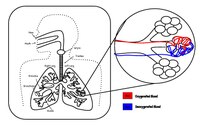
Photo from wikipedia
Abstract Membrane technology is employed in large-scale removal of acid gases from natural gas, and cellulose acetate is by far the most adopted material for this application. Because of its… Click to show full abstract
Abstract Membrane technology is employed in large-scale removal of acid gases from natural gas, and cellulose acetate is by far the most adopted material for this application. Because of its utmost industrial relevance, we analyzed the gas sorption behavior of CO2–CH4 mixtures in cellulose triacetate (CTA) at 35 °C. CO2 solubility in CTA was only slightly affected by the presence of methane, whereas competition effects sharply reduced CH4 uptake. Regardless of mixture concentration, CO2 vs. CH4 solubility coefficients regressed linearly, which translated in solubility selectivities that increased as equilibrium pressures increased. Specifically, compared to other relevant glassy polymer membrane materials, CTA positioned very close to the solubility selectivity upper bound at infinite dilution and demonstrated the highest affinity to CO2 at all investigated pressures. The experimental solubility and permeability data were used in the framework of the solution-diffusion theory to determine pure- and mixed-gas concentration averaged diffusion coefficients of CTA. CO2 diffusion was essentially unaffected by mixture effects, whereas methane diffusivity was boosted by the CO2-induced plasticization of CTA. The ratio between the pure- and mixed-gas concentration averaged diffusion coefficients of methane was used to quantify the effect of plasticization on the mixed-gas performance of CTA and other relevant membrane materials previously analyzed in similar experimental studies. When we further extended this comparison in a mixed-gas diffusion analysis (at 10 atm partial pressure), we observed that CTA had lower diffusion selectivity due to an inferior size-sieving capability than a reference material, 6FDA-mPDA polyimide, but displayed superior solubility selectivity.
Journal Title: Journal of Membrane Science
Year Published: 2020
Link to full text (if available)
Share on Social Media: Sign Up to like & get
recommendations!